Digitalisation to Improve Automated Agro-Export Logistics: A Comprehensive Bibliometric Analysis
Abstract
1. Introduction
2. Materials and Methods
2.1. Data
2.2. Procedure

3. Results
| Authors | Contribution Block | Digitalisation Guidelines for Improving Logistics |
|---|---|---|
| Butollo, (2021) [48]; Cancelas et al. (2020) [49]; Gizetdinov, (2024) [50]; Guseva et al. (2021) [51]; Huliahina, (2022) [52]; Marchenko, (2023) [53]; Mishrif and Khan, (2023) [54]; Osetskyi et al. (2024) [55]; Raamets et al. (2024) [56]; Saddique et al. (2023) [57]; Supriadi et al. (2024) [58]. | Governance, policies and social considerations in logistics digitisation: Examines the implications of digitisation from a governance and policy perspective, as well as its social impact on logistics, highlighting the need to design public policies that favour the implementation of digital technologies in logistics, including automation to improve efficiency and sustainability in the supply chain, as well as the importance of establishing regulations that guarantee the security and proper handling of data in a sector, company, etc. It also analyses how digitalisation can contribute to sustainable development and to the well-being of communities involved in cross-border trade. | Development of policy and social considerations in the digitisation of logistics and implementation of digital technologies to optimise logistics processes in the port sector by assessing the geographical implications of digitisation and its impact on the supply chain. |
| Beaulieu and Bentahar, (2021) [59]; Elock and Breka, (2023) [60]; Garg et al. (2024) [61]; Ghobakhloo et al. (2023) [62]; Ghobakhloo et al. (2024) [63]; Gourlis and Kovacic, (2022) [64]; Nzama and Telukdarie, 2020 [65]; Rösch et al. (2022) [66]. | Technological integration and automation in cross-border logistics: Addresses the importance of integrating advanced technologies such as the Internet of Things (IoT), automation and artificial intelligence to transform cross-border logistics. It looks at studies that explore how these technologies enhance connectivity and automation in the transport of goods, improving traceability, real-time monitoring and operational efficiency in the movement of goods across borders. It considers the adoption of innovations to optimise logistics operations such as the use of routing to improve the supply chain by focusing on maximising performance by identifying factors such as real-time monitoring and resilience. | Integrate advanced technologies and automation in cross-border logistics and develop systematic strategies for companies to assess current capacity and prioritise efforts to digitise and strategically align with digital capabilities to enable better supply chain management. |
| Al-Ababneh et al. (2023) [67]; Albarracín, (2023) [68]; Alherimi et al. (2024) [69]; Barba et al. (2023) [70]; El Hamdi and Abouabdellah, (2022) [7]; Escherle et al. (2023) [71]; Krstić et al. (2022) [72]; Malhotra et al. (2024) [73]; Rokicki et al. (2022) [74]; Wilsky et al. (2022) [75]; Yontar, (2023) [76]; Zoubek and Simon, (2021) [77]. | Impact of digitalisation on logistics efficiency and the supply chain: Focusing on how digitisation has a direct impact on logistics efficiency by improving processes within the supply chain, these included studies analyse the implementation of digital technologies to optimise response times, reduce operational costs and improve coordination between different logistics actors. Emphasis is placed on leveraging digital systems to streamline the transport and distribution of products, highlighting improvements in the overall efficiency of the chain and thus also improving efficiency and sustainability in the agri-food sector. | Application of 4.0 technologies to optimise logistics processes and promote sustainable practices to improve logistics efficiency through digitisation in the supply chain by integrating digital marketing and logistics strategies to optimise business performance. |
4. Discussion
5. Conclusions
Author Contributions
Funding
Institutional Review Board Statement
Informed Consent Statement
Data Availability Statement
Conflicts of Interest
References
- Boulton, T.J.; Ellram, L.M. The intersection of supply chain operations and finance: Logistics uncertainty and International IPO underpricing. Transp. Res. Part E Logist. Transp. Rev. 2024, 189, 103641. [Google Scholar] [CrossRef]
- Gani, A. The Logistics Performance Effect in International Trade. Asian J. Shipp. Logist. 2017, 33, 279–288. [Google Scholar] [CrossRef]
- Vorona, A.; Istomin, L.; Kalmykov, S. Peculiarities of international postal items logistics. Transp. Res. Procedia 2022, 63, 1872–1880. [Google Scholar] [CrossRef]
- Zhao, Y.; Wang, S.; Liu, X.; Tang, X. Effect of the logistics industry on the promotion of China’s position in the global value chain: An international trade perspective. Int. Rev. Econ. Financ. 2023, 86, 834–847. [Google Scholar] [CrossRef]
- Tiwari, M.K.; Bidanda, B.; Geunes, J.; Fernandes, K.; Dolgui, A. Supply chain digitisation and management. Int. J. Prod. Res. 2024, 62, 2918–2926. [Google Scholar] [CrossRef]
- Elhusseiny, H.M.; Crispim, J. A Review of Industry 4.0 Maturity Models: Adoption of SMEs in the Manufacturing and Logistics Sectors. Procedia Comput. Sci. 2023, 219, 236–243. [Google Scholar] [CrossRef]
- El Hamdi, S.E.l.; Abouabdellah, A. Logistics: Impact of Industry. Appl. Sci. 2022, 12, 4209. [Google Scholar] [CrossRef]
- ECLAC. Digital technologies for the new future. Educitec Rev. Estud. Pesqui. Sobre Ensino Tecnológico 2021, 8, e198522. Available online: https://www.cepal.org/en/publications/46817-digital-technologies-new-future (accessed on 20 July 2024).
- Valdés Figueroa, L.; Pérez, G. Transformación digital en la logística de América Latina y el Caribe. Boletín 2020, 381, 1–18. Available online: https://www.cepal.org/es/publicaciones/46018-transformacion-digital-la-logistica-america-latina-caribe (accessed on 20 July 2024).
- Suárez, D.; Pérez, G. Digitalization of trade logistics in landlocked countries in South America. Boletín 2021, 385, 1–18. Available online: https://www.cepal.org/en/publications/46798-digitization-trade-logistics-landlocked-countries-south-america (accessed on 20 July 2024).
- Shikur, Z.H. Logistics Performance, Export, Agricultural, Manufacturing, and Aggregate Economic Growth: A Focus on Sectoral Perspectives. J. Econ. Dev. 2022, 47, 107–123. [Google Scholar] [CrossRef]
- Hamidi, S.M.M.; Hoseini, S.F.; Gholami, H.; Kananizadeh-Bahmani, M. A three-stage digital maturity model to assess readiness for blockchain implementation in the maritime logistics industry. J. Ind. Inf. Integr. 2024, 41, 100643. [Google Scholar] [CrossRef]
- Liu, Y.; Pan, S.; Ballot, E. Unveiling the potential of digital twins in logistics and supply chain management: Services, capabilities, and research opportunities. Digit. Eng. 2024, 3, 100025. [Google Scholar] [CrossRef]
- Sardarabady, N.J.; Durst, S. A systematic literature review on the economic impact of digitalization technologies in transport logistics. Transp. Econ. Manag. 2024, 2, 76–89. [Google Scholar] [CrossRef]
- Zhu, Y.; Cheng, J.; Liu, Z.; Cheng, Q.; Zou, X.; Xu, H.; Wang, Y.; Tao, F. Production logistics digital twins: Research profiling, application, challenges and opportunities. Robot. Comput. Integr. Manuf. 2023, 84, 102592. [Google Scholar] [CrossRef]
- Almeman, A. The digital transformation in pharmacy: Embracing online platforms and the cosmeceutical paradigm shift. J. Health Popul. Nutr. 2024, 43, 41043. [Google Scholar] [CrossRef]
- Marquardt, L.; Harima, A. Digital boundary spanning in the evolution of entrepreneurial ecosystems: A dynamic capabilities perspective. J. Bus. Res. 2024, 182, 114762. [Google Scholar] [CrossRef]
- Bhowmik, O.; Chowdhury, S.; Ashik, J.H.; Mahmud, G.I.; Khan, M.M.; Hossain, N.U.I. Application of artificial intelligence in reverse logistics: A bibliometric and network analysis. Supply Chain Anal. 2024, 7, 100076. [Google Scholar] [CrossRef]
- Castro, H.; Camara, E.; Avila, P.; Cruz-Cunha, M.; Ferreira, L. Artificial Intelligence Models: A literature review addressing Industry 4.0 approach. Procedia Comput. Sci. 2024, 239, 2369–2376. [Google Scholar] [CrossRef]
- Idrissi, Z.K.; Lachgar, M.; Hrimech, H. Blockchain, IoT and AI in logistics and transportation: A systematic review. Transp. Econ. Manag. 2024, 2, 275–285. [Google Scholar] [CrossRef]
- Mishra, R.; Kr Singh, R.; Daim, T.U.; Fosso Wamba, S.; Song, M. Integrated usage of artificial intelligence, blockchain and the internet of things in logistics for decarbonization through paradox lens. Transp. Res. Part E Logist. Transp. Rev. 2024, 189, 103684. [Google Scholar] [CrossRef]
- Ye, D.; Xu, B.; Wei, B.; Zheng, L.; Wu, Y.J. Employee work engagement in the digital transformation of enterprises: A fuzzy-set qualitative comparative analysis. Humanit. Soc. Sci. Commun. 2024, 11, 41599. [Google Scholar] [CrossRef]
- Chen, Q.A.; Zhao, X.; Zhang, X.; Jiang, Z.; Wang, Y. Driving forces of digital transformation in chinese enterprises based on machine learning. Sci. Rep. 2024, 14, 56448. [Google Scholar] [CrossRef]
- Galindo, M.A.; Ribeiro, D.; Mendez, M.T. Innovación y crecimiento económico: Factores que estimulan la innovación. Cuad. Gest. 2012, 12, 51–58. [Google Scholar] [CrossRef]
- Rojo Gutiérrez, M.A.; Padilla-Oviedo, A.; Riojas, R.M. La innovación y su importancia. Rev. Cient. UISRAEL 2019, 6, 9–22. [Google Scholar] [CrossRef]
- Torres, M.L. Beneficios de las TICs en una Empresa Agroexportadora en el año 2020. Bachelor’s Thesis, Universidad Privada del Norte, Trujillo, Peru, 2023. Available online: https://repositorio.upn.edu.pe/handle/11537/36160?locale-attribute=es (accessed on 22 August 2024).
- Rondón-Aquino, V.; Reategui-Jauregui, T.T.A.; Olórtegui-Alcalde, L.M.; Bernia-León, W.C.; Vargas-Merino, J.A. Digitalization and customer acquisition in companies in Latin America. A systematic review of the literature 2013–2023 [Digitalización y captación de clientes en empresas a nivel Latinoamérica. Una Revisión Sistemática de la Literatura 2013–2023]. In Proceedings of the LACCEI International Multi-Conference for Engineering, Education and Technology, Buenos Aires, Argentina, 17–21 July 2023; Volume 71612. [Google Scholar]
- Martinez Negron, M.d.P.; Núñez Pardo, V.M. Producción y Exportación de Mango Fresco por las Principales Exportadoras de la Región Piura en Épocas de Pandemia, 2020. Bachelor’s Thesis, Universidad Cesar Vallejo, Trujillo, Peru, 2020. Repositorio de la Universidad César Vallejo. Available online: https://repositorio.ucv.edu.pe/handle/20.500.12692/122788 (accessed on 28 August 2024).
- Agyei, V.; Adom-Asamoah, G.; Poku-Boansi, M. Sustainable transportation in Africa: A bibliometric, visualisation and thematic analysis. J. Clean. Prod. 2024, 462, 142727. [Google Scholar] [CrossRef]
- Haddow, G. Bibliometric research. In Research Methods: Information, Systems, and Contexts: Second Edition; Elsevier: Amsterdam, The Netherlands, 2018; pp. 241–266. [Google Scholar] [CrossRef]
- Hernandez Sampieri, R.; Fernandez Collado, C.; Baptisa Lucio, P. Metodología de la Investigación, 6th ed.; Dialnet: España City, España, 2014; Available online: https://dialnet.unirioja.es/servlet/libro?codigo=775008 (accessed on 28 August 2024).
- Briner, R.B.; Denyer, D. Systematic Review and Evidence Synthesis as a Practice and Scholarship Tool. In The Oxford Handbook of Evidence-Based Management; Oxford University Press: Oxford, UK, 2012. [Google Scholar] [CrossRef]
- Navrotsky, Y.; Patsei, N. Zipf’s Distribution Caching Application in Named Data Networks. In Proceedings of the 2021 IEEE Open Conference of Electrical, Electronic and Information Sciences, EStream 2021—Proceedings, Vilnius, Lithuania, 22 April 2021. [Google Scholar] [CrossRef]
- Kwasi Bannor, R.; Kofi Arthur, K. A systematic review and bibliometric analysis on agribusiness gaps in emerging markets. Res. Glob. 2024, 8, 100214. [Google Scholar] [CrossRef]
- Cobo, M.J.; López-Herrera, A.G.; Herrera-Viedma, E.; Herrera, F. Science mapping software tools: Review, analysis, and cooperative study among tools. J. Am. Soc. Inf. Sci. Technol. 2011, 62, 1382–1402. [Google Scholar] [CrossRef]
- Gallego-Losada, R.; Montero-Navarro, A.; Rodríguez-Sánchez, J.-L.; González-Torres, T. Retirement planning and financial literacy, at the crossroads. A bibliometric analysis. Financ. Res. Lett. 2022, 44, 102109. [Google Scholar] [CrossRef]
- Liao, H.; Tang, M.; Luo, L.; Li, C.; Chiclana, F.; Zeng, X.J. A Bibliometric Analysis and Visualization of Medical Big Data Research. Sustainability 2018, 10, 166. [Google Scholar] [CrossRef]
- Aria, M.; Cuccurullo, C. bibliometrix: An R-tool for comprehensive science mapping analysis. J. Informetr. 2017, 11, 959–975. [Google Scholar] [CrossRef]
- Atabay, E.; Güzeller, C.O. A Bibliometric Study on Eye-Tracking Research in Tourism. Tourism 2021, 69, 595–610. [Google Scholar] [CrossRef]
- Yepes-Nuñez, J.J.; Urrútia, G.; Romero-García, M.; Alonso-Fernández, S. The PRISMA 2020 statement: An updated guideline for reporting systematic reviews. Rev. Esp. Cardiol. 2021, 74, 790–799. [Google Scholar] [CrossRef]
- Pérez, M. The scientific production on social innovation for local development: A bibliometric review the structure and evolution of the field of scientific domain. Prism. Soc. 2017, 19, 146–182. Available online: http://www.scopus.com/inward/record.url?eid=2-s2.0-85041131552&partnerID=MN8TOARS (accessed on 30 August 2024).
- Cortez Clavo, L.K.; Salazar Muñoz, M.I.; Morán Santamaría, R.O. Digitalisation to improve automated agro-export logistics: Comprehensive bibliometric analysis. Zenodo 2025. [Google Scholar] [CrossRef]
- Bibliometrix. Bibliometrix Is an Open Source Tool for Quantitative Research in Scientometrics and Bibliometrics. 2023. Available online: https://www.bibliometrix.org/home/ (accessed on 30 August 2024).
- VOSviewer. VOSviewer, Software Tool for Building and Visualizing Bibliometric Networks. 2023. Available online: https://www.vosviewer.com/ (accessed on 30 August 2024).
- Haddaway, N.R.; Page, M.J.; Pritchard, C.C.; McGuinness, L.A. PRISMA2020: An R package and Shiny app for producing PRISMA 2020-compliant flow diagrams, with interactivity for optimised digital transparency and Open Synthesis. Campbell Syst. Rev. 2022, 18, e1230. [Google Scholar] [CrossRef]
- Universidad César Vallejo. Código de Ética de Investigación de la Universidad César Vallejo, Versión 02. 9 November 2024. Available online: https://www.ucv.edu.pe/transparencia (accessed on 30 August 2024).
- Palomares-Montero, D.; Chisvert-Tarazona, M.J.; Suárez-Ortega, M. Training and guidance for entrepreneurship. What bibliometrics and novice entrepreneurs say. Rev. Esp. Orientac. Psicopedag. 2019, 30, 131–149. [Google Scholar] [CrossRef]
- Butollo, F. Digitalization and the geographies of production: Towards reshoring or global fragmentation? Compet. Change 2021, 25, 259–278. [Google Scholar] [CrossRef]
- Cancelas, N.G.; Serrano, B.M.; Infantes, M.E.; Flores, F.S.; Orive, A.C. Escenario de digitalización para el sistema portuario español. Rev. Transp. Territ. 2020, 22, 258–279. [Google Scholar] [CrossRef]
- Gizetdinov, R. Automation and digitalisation of transport forwarding services or logistics. Infrastruct. Asset Manag. 2024, 11, 100–107. [Google Scholar] [CrossRef]
- Guseva, E.A.; Konstantinova, M.V.; Olentsevich, V.A.; Konyukhov, V.Y.; Olentsevich, A.A. Automation of individual operations of the transport process to create sufficient conditions for the efficient functioning of digital transport and logistics. IOP Conf. Ser. Mater. Sci. Eng. 2021, 1064, 012014. [Google Scholar] [CrossRef]
- Huliahina, O. Digital Transformation of Supply Chains in the Modern Conditions of a Changing Environment. Vestn. Polotsk State Univ. Part D Econ. Leg. Sci. 2022, 62, 16–19. [Google Scholar] [CrossRef]
- Marchenko, M. Digitalization of business management processes of agricultural enterprises. Galic’kij Ekon. Visn. 2023, 81, 133–139. [Google Scholar] [CrossRef]
- Mishrif, A.; Khan, A. Digitization policy design and implementation in the logistics and supply chain sector during the time of COVID-19. J. Int. Logist. Trade 2023, 21, 135–158. [Google Scholar] [CrossRef]
- Osetskyi, V.; Umantsiv, Y.; Klymenko, V.; Lozova, G.; Yeshchenko, E. Digitization of Macro-Logistics Systems in Ukraine. Adv. Politics Econ. 2024, 7, 9. [Google Scholar] [CrossRef]
- Raamets, T.; Majak, J.; Karjust, K.; Mahmood, K.; Hermaste, A. Autonomous mobile robots for production logistics: A process optimization model modification [Autonoomsed mobiilsed robotid tootmislogistikas: Protsessi optimeerimismudeli muutmine]. Proc. Est. Acad. Sci. 2024, 73, 134–141. [Google Scholar] [CrossRef]
- Saddique, F.; Rameshbhai Patel, K.; Niaz, M.; Chukwu, M.U.; Nwagwu, U. Impact of Supply Chain Transformation on Supply Chain Performance: The Empirical Study that Bases on Mediating Role of Supply Chain Resilience on Construction Organization on Pakistan. Asian J. Eng. Soc. Health 2023, 2, 1072–1086. [Google Scholar] [CrossRef]
- Supriadi, I.; Maghfiroh, R.U.; Abadi, R. Digital Revolution in Supply Chain Finance: Overcoming Challenges and Building Innovative Strategies. Klabat Account. Rev. 2024, 5, 47. [Google Scholar] [CrossRef]
- Beaulieu, M.; Bentahar, O. Digitalization of the healthcare supply chain: A roadmap to generate benefits and effectively support healthcare delivery. Technol. Forecast. Soc. Change 2021, 167, 120717. [Google Scholar] [CrossRef]
- Elock Son, C.; Breka, J.N. Digitalization and industry 4.0 within the supply chain: A review of contributions and barriers. Rev. Française Gest. Ind. 2023, 37, 55–70. [Google Scholar] [CrossRef]
- Garg, P.; Gupta, B.; Sar, A.; Graham, G.; Shore, A.P. Development and Validation of an Instrument to Measure the Perceived Benefits of Digitalization in Manufacturing. IEEE Trans. Eng. Manag. 2024, 71, 8288–8306. [Google Scholar] [CrossRef]
- Ghobakhloo, M.; Iranmanesh, M.; Foroughi, B.; Tseng, M.L.; Nikbin, D.; Khanfar, A.A.A. Industry 4.0 digital transformation and opportunities for supply chain resilience: A comprehensive review and a strategic roadmap. Prod. Plan. Control 2023, 36, 61–91. [Google Scholar] [CrossRef]
- Ghobakhloo, M.; Iranmanesh, M.; Mubarik, M.S.; Mubarak, M.F.; Amran, A.; Khanfar, A.A.A. Blockchain technology as an enabler for sustainable business ecosystems: A comprehensive roadmap for socioenvironmental and economic sustainability. Bus. Strategy Dev. 2024, 7, e319. [Google Scholar] [CrossRef]
- Gourlis, G.; Kovacic, I. A holistic digital twin simulation framework for industrial facilities: BIM-based data acquisition for building energy modeling. Front. Built Environ. 2022, 8, 918821. [Google Scholar] [CrossRef]
- Nzama, S.; Telukdarie, A. Digitalization of interlocking system to optimize logistics in railway transportation. Int. J. Bus. Anal. 2020, 7, 24–36. [Google Scholar] [CrossRef]
- Rösch, A.L.; Härting, R.C.; Gakharia, S. The transformation of global value chains in the age of COVID-19 and Digitization. Procedia Comput. Sci. 2022, 207, 2474–2482. [Google Scholar] [CrossRef] [PubMed]
- Al-Ababneh, H.A.; Dalbouh, M.A.A.; Alrhaimi, S.A.S.; Siam, I.M.; Ibragimkhalilova, T. Digitalization, innovation and marketing in logistics. Acta Logist. 2023, 10, 615–624. [Google Scholar] [CrossRef]
- Albarracín Vanoy, R.J. Logistics 4.0: Exploring Artificial Intelligence Trends in Efficient Supply Chain Management. Data Metadata 2023, 2, 2023145. [Google Scholar] [CrossRef]
- Alherimi, N.; Saihi, A.; Ben-Daya, M. A Systematic Review of Optimization Approaches Employed in Digital Warehousing Transformation. IEEE Access 2024, 12, 145809–145831. [Google Scholar] [CrossRef]
- Barba, J.D.L.M.; González-Cancelas, N.; Orive, A.C. BOT methodology for the inclusion of Spanish ports into the international logistics market as Ports 4.0. Proc. Inst. Civ. Eng. Smart Infrastruct. Constr. 2023, 176, 148–162. [Google Scholar] [CrossRef]
- Escherle, S.; Darlagiannis, E.; Sprung, A. Automated Trucks and the Future of Logistics—A Delphi-Based Scenario Study. Logist. Res. 2023, 16, 1–21. Available online: https://www.scopus.com/record/display.uri?eid=2-s2.0-85149129909&origin=resultslist&sort=plf-f&src=s&sot=b&sdt=b&s=TITLE-ABS-KEY%28Automated+Trucks+and+the+Future+of+Logistics%E2%80%94A+Delphi-Based+Scenario+Study%29 (accessed on 30 August 2024).
- Krstić, M.; Agnusdei, G.P.; Miglietta, P.P.; Tadić, S. Logistics 4.0 toward circular economy in the agri-food sector. Sustain. Futures 2022, 4, 100097. [Google Scholar] [CrossRef]
- Malhotra, S.; Singh, S.; Hussaini, T. Technological Forecasting & Social Change Impact of Digitalisation on Service Delivery in Dubai’s Retail Industry. Proc. Eng. Sci. 2024, 6, 959–966. [Google Scholar] [CrossRef]
- Rokicki, T.; Bórawski, P.; Bełdycka-Bórawska, A.; Szeberényi, A.; Perkowska, A. Changes in Logistics Activities in Poland as a Result of the COVID-19 Pandemic. Sustainability 2022, 14, 10303. [Google Scholar] [CrossRef]
- Wilsky, P.; Franke, F.; Fischer, D.; Gassenbauer, F.; Riedel, R. Technology Combinations for Identification and Localization in Production. The Use Cases of Digital Technologies in Production Are Experiencing Continuous Growth [Technologiekombinationen zur Identifikation und Lokalisierung in der Produktion]. Z. Wirtsch. Fabr. 2022, 117, 768–772. [Google Scholar] [CrossRef]
- Yontar, E. The role of blockchain technology in the sustainability of supply chain management: Grey based dematel implementation. Clean. Logist. Supply Chain 2023, 8, 100113. [Google Scholar] [CrossRef]
- Zoubek, M.; Simon, M. A framework for a logistics 4.0 maturity model with a specification for internal logistics. MM Sci. J. 2021, 2021, 4264–4274. [Google Scholar] [CrossRef]
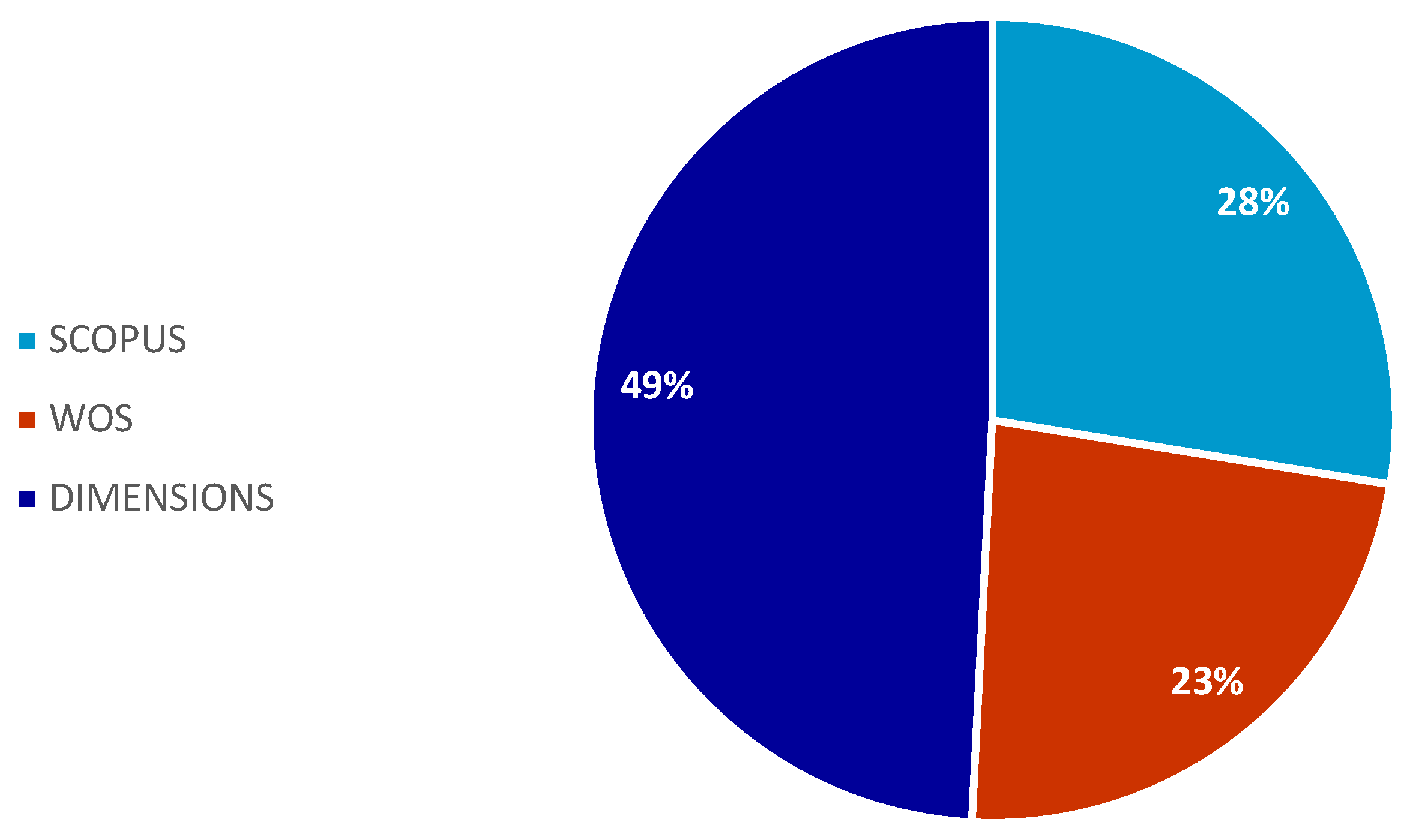
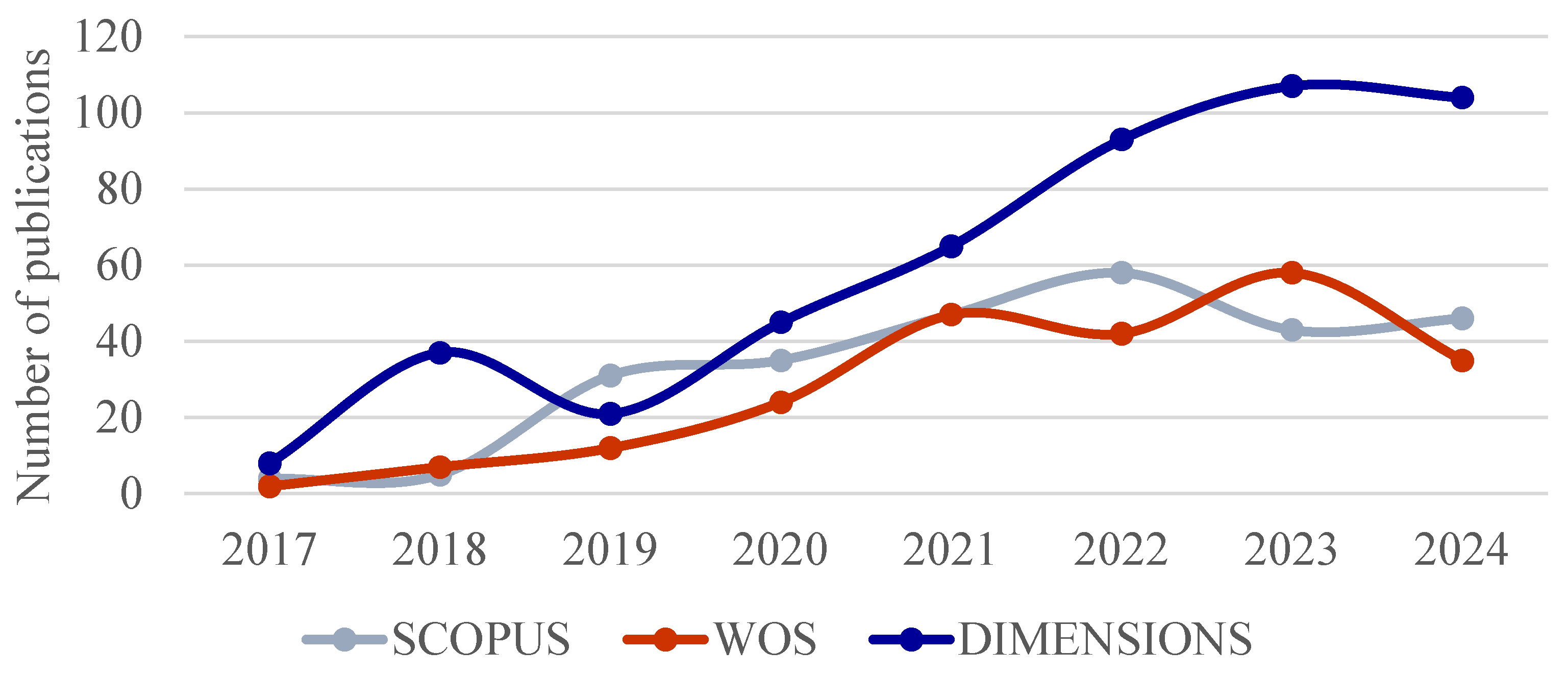
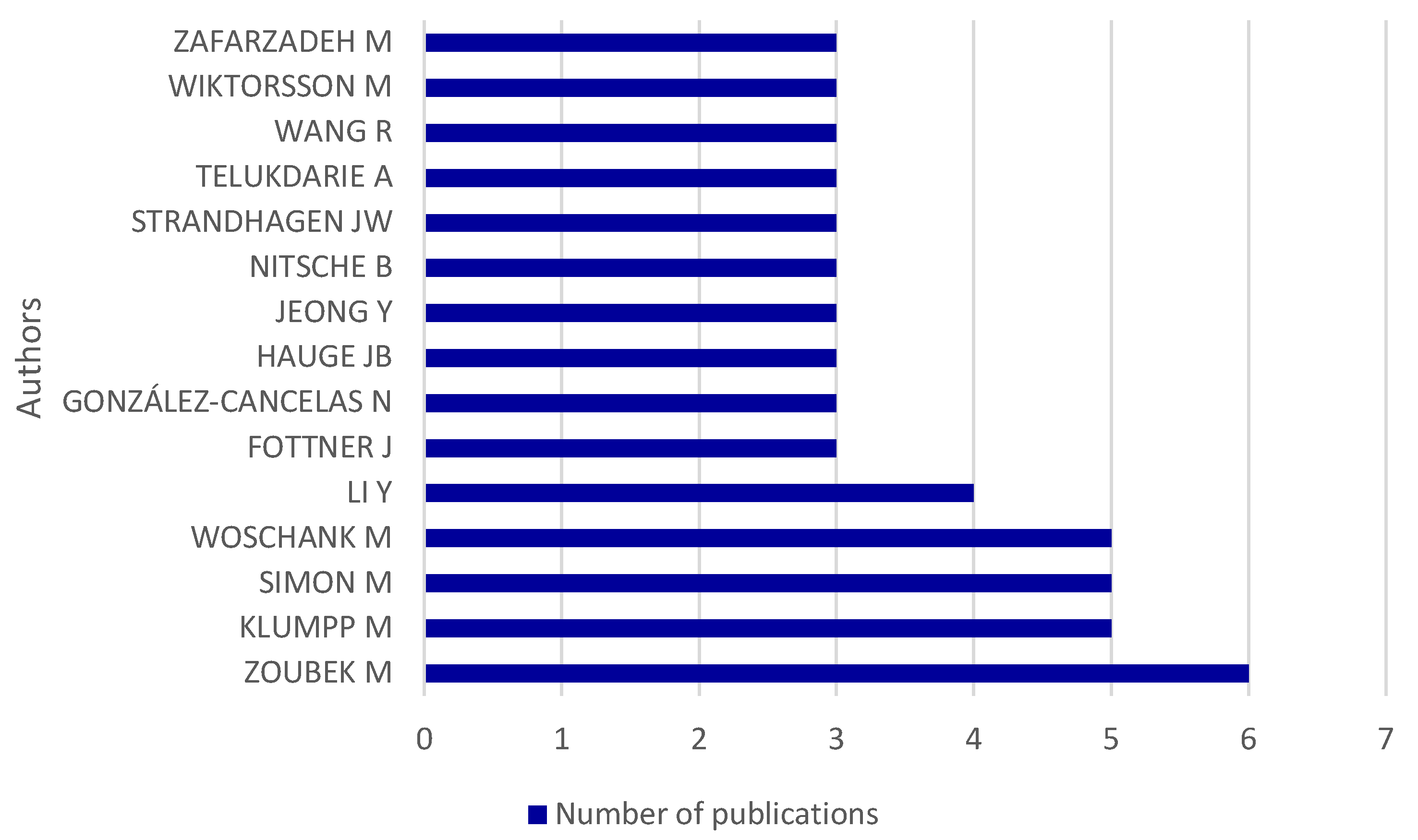

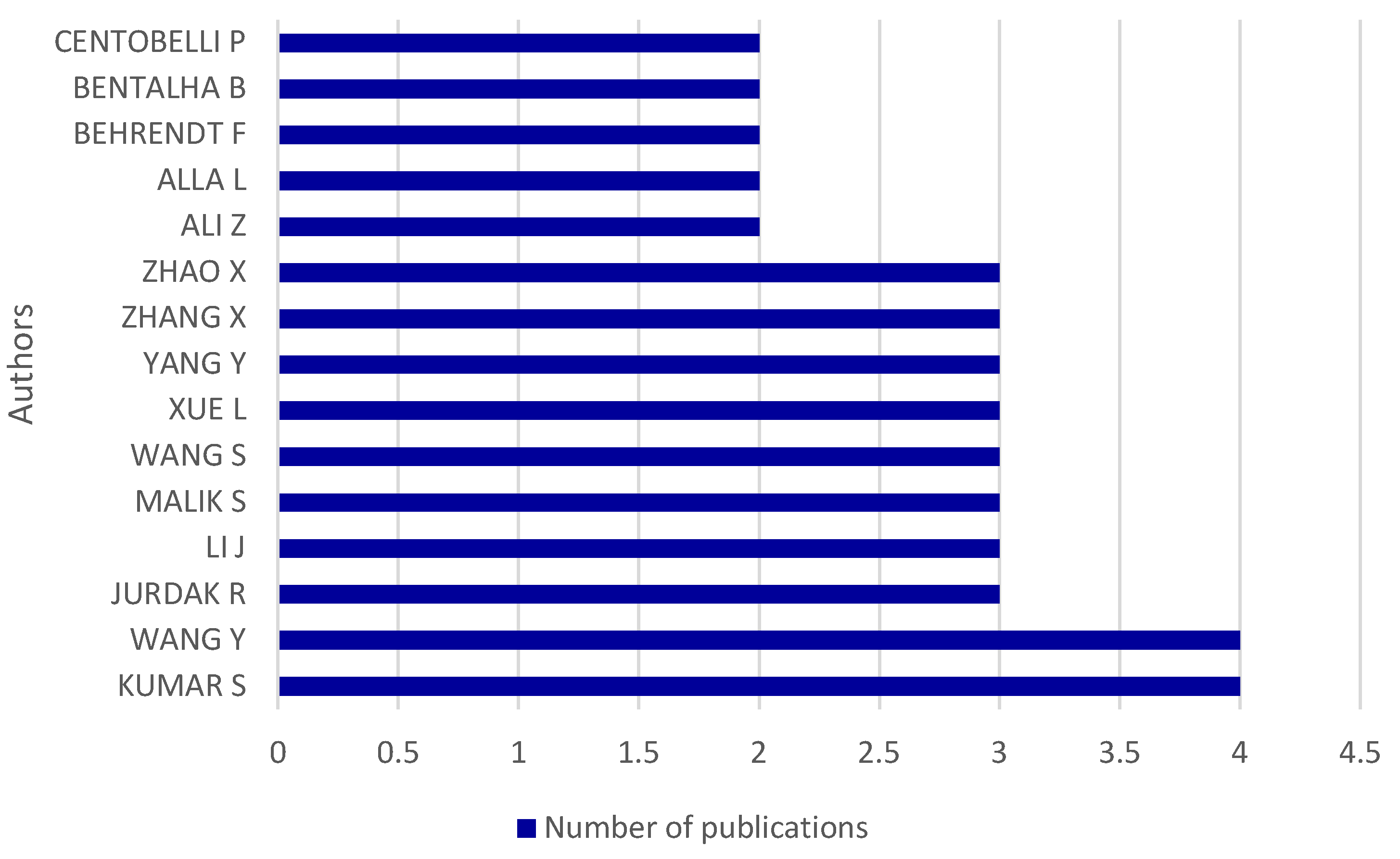
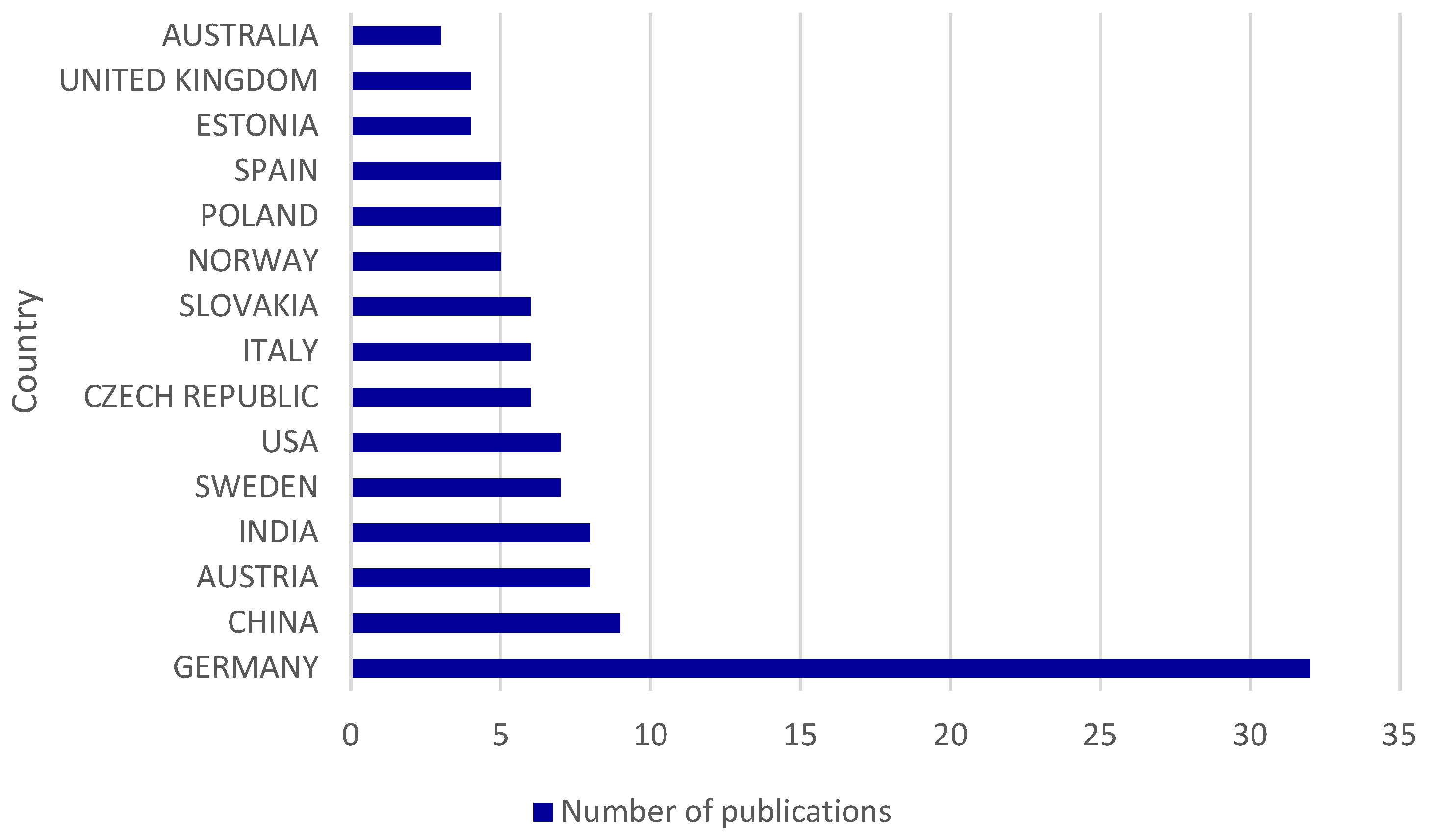

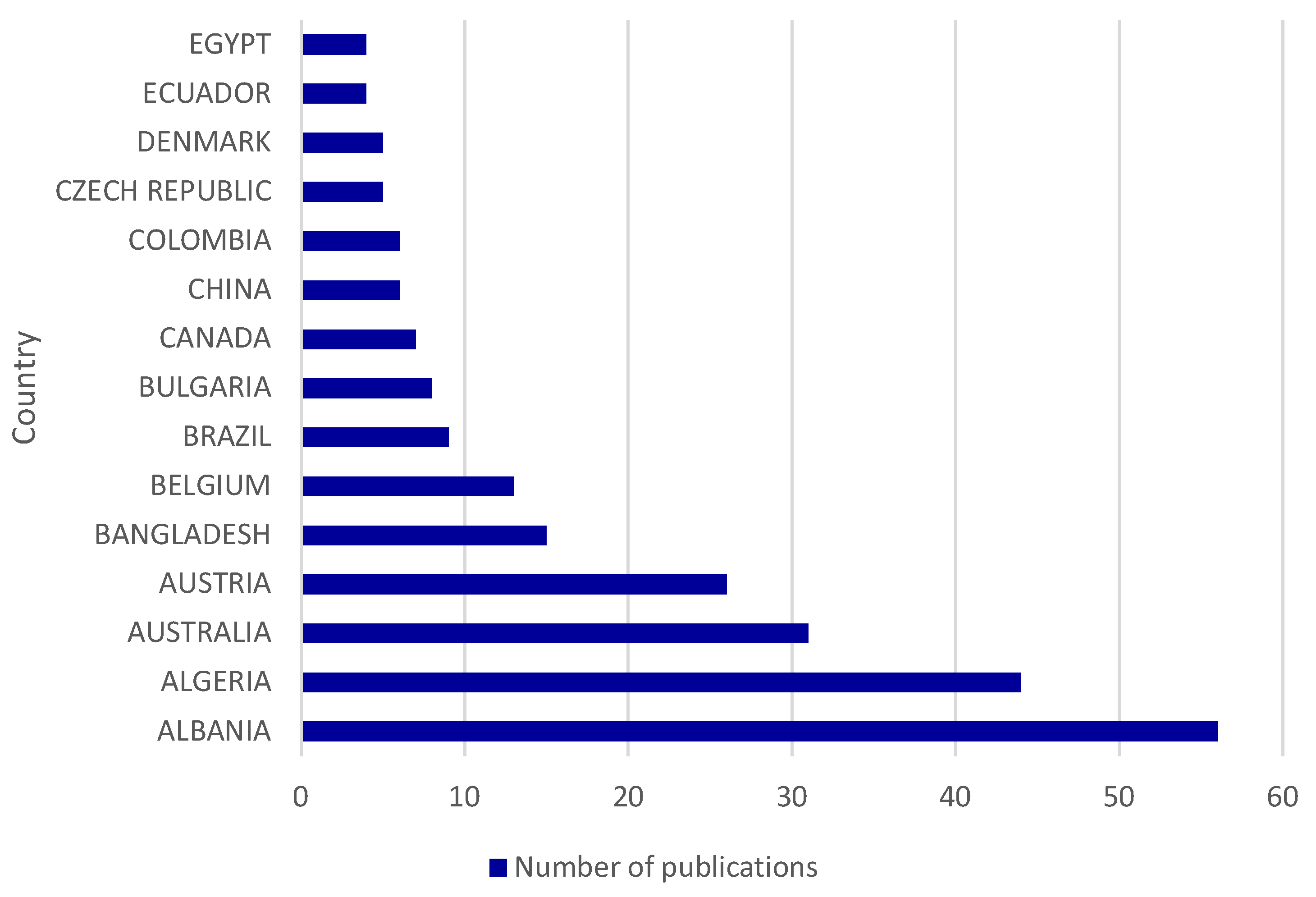
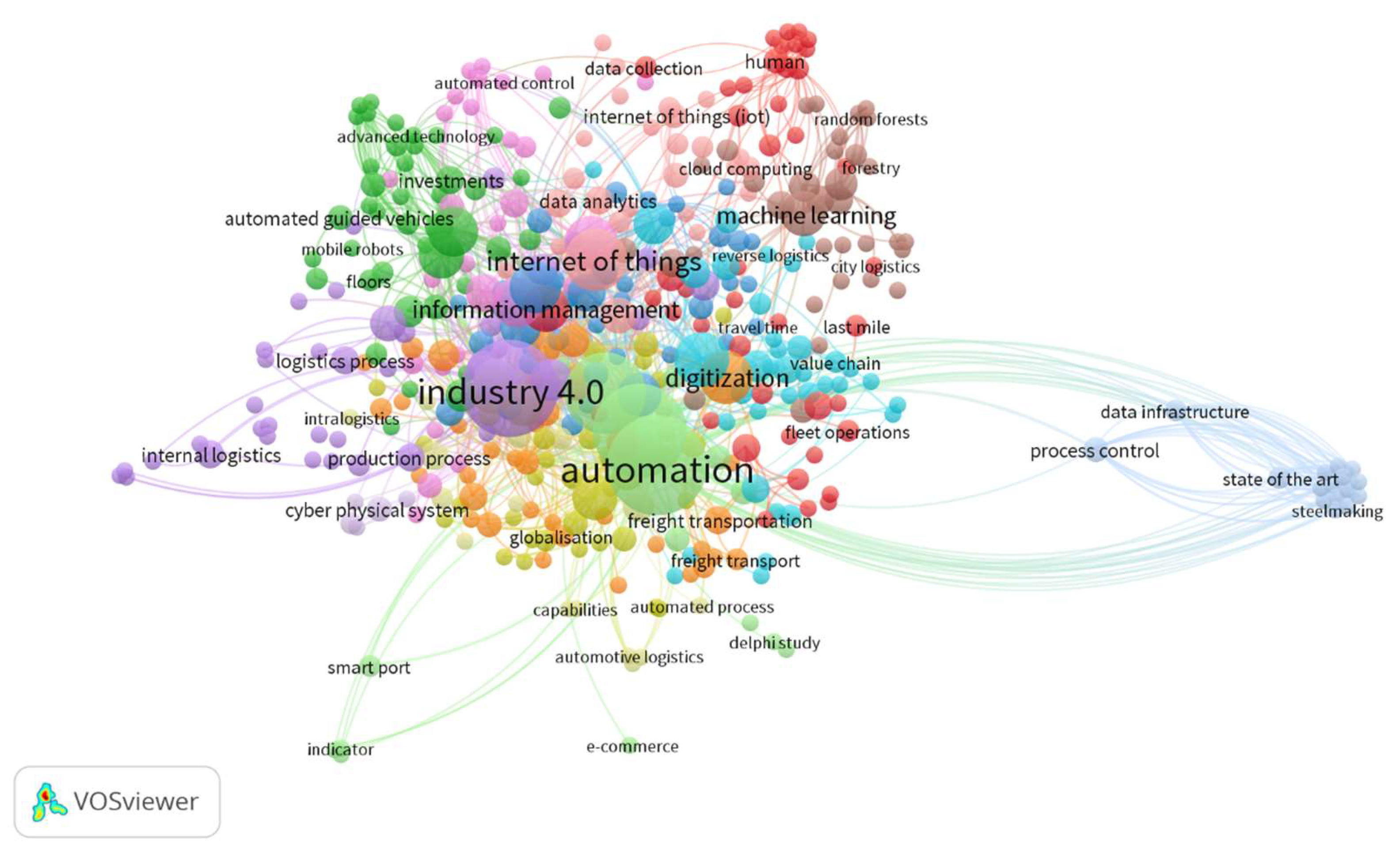

| Database | Search Protocol | Documents |
|---|---|---|
| Scopus | (TITLE-ABS-KEY (digitisation OR digitisation) AND TITLE-ABS-KEY (automation OR automated) AND TITLE- ABS-KEY (logistic) AND ALL (international)) | 281 |
| WOS | TS = (“digitalization” OR “digitization”) AND TS = (“automation” OR “automated”) AND TS = (“logistics” OR “supply chain”) | 230 |
| Dimensions | “digitalization” OR “digitization” AND “logistics” OR “supply chain” AND “automation” OR “automated”. | 835 |
| Total, documents | 1346 | |
| Magazine | Ranking | Frequency | Cumulative Frequency | Zone |
|---|---|---|---|---|
| Lecture Notes in Networks and Systems | 1 | 15 | 15 | Zone 1 |
| Sustainability (Switzerland) | 2 | 7 | 22 | Zone 1 |
| ACM International Conference Proceeding Series | 3 | 5 | 27 | Zone 1 |
| Applied Sciences (Switzerland) | 4 | 5 | 32 | Zone 1 |
| IFIP Advances in Information and Communication Technology | 5 | 5 | 37 | Zone 1 |
| Lecture Notes in Logistics | 6 | 5 | 42 | Zone 1 |
| E3S Web of Conferences | 7 | 4 | 46 | Zone 1 |
| IEEE Access | 8 | 4 | 50 | Zone 1 |
| Lecture Notes in Computer Science (Including Subseries Lecture Notes in Artificial Intelligence and Lecture Notes in Bioinformatics) | 9 | 4 | 54 | Zone 1 |
| Logistics | 10 | 4 | 58 | Zone 1 |
| Logistics ACT | 11 | 3 | 61 | Zone 1 |
| IOP Conference Series: Materials Science and Engineering | 12 | 3 | 64 | Zone 1 |
| Magazine | Ranking | Frequency | Cumulative Frequency | Zone |
|---|---|---|---|---|
| Sustainability | 1 | 13 | 13 | Zone 1 |
| Applied Sciences-Basel | 2 | 8 | 21 | Zone 1 |
| IEEE Access | 3 | 6 | 27 | Zone 1 |
| Computers in Industry | 4 | 5 | 32 | Zone 1 |
| International Journal of Production Research | 5 | 5 | 37 | Zone 1 |
| Logistics-Basel | 6 | 5 | 42 | Zone 1 |
| Technological Forecasting and Social Change | 7 | 5 | 47 | Zone 1 |
| Journal of Cleaner Production | 8 | 4 | 51 | Zone 1 |
| Cleaner Logistics and Supply Chain | 9 | 3 | 54 | Zone 1 |
| Information Systems Frontiers | 10 | 3 | 57 | Zone 1 |
| Journal of Manufacturing Technology Management | 11 | 3 | 60 | Zone 1 |
| Production Planning and Control | 12 | 3 | 63 | Zone 1 |
| Magazine | Ranking | Frequency | Cumulative Frequency | Zone |
|---|---|---|---|---|
| Springer Series in Supply Chain Management | 1 | 23 | 23 | Zone 1 |
| Sustainability | 2 | 16 | 39 | Zone 1 |
| NA | 3 | 14 | 53 | Zone 1 |
| Lecture Notes in Networks and Systems | 4 | 10 | 63 | Zone 1 |
| Advances In Logistics, Operations, And Management Science | 5 | 8 | 71 | Zone 1 |
| SSRN Electronic Journal | 6 | 8 | 79 | Zone 1 |
| Lecture Notes in Logistics | 7 | 5 | 84 | Zone 1 |
| Lecture Notes in Mechanical Engineering | 8 | 4 | 88 | Zone 1 |
| Operations Management Research | 9 | 4 | 92 | Zone 1 |
| Advanced Studies in Supply Management | 10 | 3 | 95 | Zone 1 |
| Advances In Economics Management and Political Sciences | 11 | 3 | 98 | Zone 1 |
| Advances in Economics, Business and Management Research | 12 | 3 | 101 | Zone 1 |
| SCOPUS | WOS | DIMENSIONS | ||||
|---|---|---|---|---|---|---|
| N. Articles | N. Authors | Freq | N. Authors | Freq | N. Authors | Freq |
| 1 | 790 | 92.3% | 765 | 94.7% | 1152 | 94% |
| 2 | 51 | 6.0% | 34 | 4.2% | 58 | 4.8% |
| 3 | 10 | 1.2% | 5 | 0.6% | 8 | 0.7% |
| 4 | 1 | 0.1% | 2 | 0.2% | 2 | 0.2% |
| 5 | 3 | 0.4% | 2 | 0% | 0 | 0% |
| 6 | 1 | 0.00116822 | 0 | 0% | 0 | 0% |
Disclaimer/Publisher’s Note: The statements, opinions and data contained in all publications are solely those of the individual author(s) and contributor(s) and not of MDPI and/or the editor(s). MDPI and/or the editor(s) disclaim responsibility for any injury to people or property resulting from any ideas, methods, instructions or products referred to in the content. |
© 2025 by the authors. Licensee MDPI, Basel, Switzerland. This article is an open access article distributed under the terms and conditions of the Creative Commons Attribution (CC BY) license (https://creativecommons.org/licenses/by/4.0/).
Share and Cite
Cortez-Clavo, L.K.; Salazar-Muñoz, M.I.; Morán-Santamaría, R.O. Digitalisation to Improve Automated Agro-Export Logistics: A Comprehensive Bibliometric Analysis. Sustainability 2025, 17, 4470. https://doi.org/10.3390/su17104470
Cortez-Clavo LK, Salazar-Muñoz MI, Morán-Santamaría RO. Digitalisation to Improve Automated Agro-Export Logistics: A Comprehensive Bibliometric Analysis. Sustainability. 2025; 17(10):4470. https://doi.org/10.3390/su17104470
Chicago/Turabian StyleCortez-Clavo, Luis Kevin, Maryorie Irania Salazar-Muñoz, and Rogger Orlando Morán-Santamaría. 2025. "Digitalisation to Improve Automated Agro-Export Logistics: A Comprehensive Bibliometric Analysis" Sustainability 17, no. 10: 4470. https://doi.org/10.3390/su17104470
APA StyleCortez-Clavo, L. K., Salazar-Muñoz, M. I., & Morán-Santamaría, R. O. (2025). Digitalisation to Improve Automated Agro-Export Logistics: A Comprehensive Bibliometric Analysis. Sustainability, 17(10), 4470. https://doi.org/10.3390/su17104470








